2022 年 62 巻 2 号 p. 361-367
2022 年 62 巻 2 号 p. 361-367
This study investigated the true stress (σ)–true strain (ε) relationship up to the plastic deformation limit in ferrite–pearlite (FP) steel at various temperatures. We found that a decrease in the deformation temperature resulted in an increase in the lower yield strength (LYS) and the tensile strength (TS), and a decrease in both the uniform and the total elongations. When the temperature was increased from 673 to 773 K, the TS increased and the uniform and total elongations decreased due to the blue brittleness. In the σ–ε relationship up to the plastic deformation limit of the FP steel at various temperatures, ε at the plastic deformation limit increased with an increase in the temperature and was correlated with the reduction of cross-sectional area of tensile specimen. Microcracks were observed in the cementite plates as well as tearing in the pearlite lamellae. The temperature dependence of fracture stress (σZ) was small. In particular, the values of σZ in the temperature range of ductile fracture was almost the same, and is applicable to the condition of the plastic deformation limit. When the ratio of LYS to σZ was 0.5, the area fraction of brittle fracture was 50%.
Structural steels are used in various applications such as for buildings and machinery parts and thus require a detailed understanding of the plastic deformation limit.1,2,3) Ferrite–pearlite (FP) steel is obtained by hot working processes, and numerous studies have examined its strength and ductility.1,2,4,5) We have been investigating the true stress (σ)–true strain (ε) relationship up to the plastic deformation limit in order to gain further insight into the limit of plastic deformation.6,7) Here, the plastic deformation limit means the limiting point or the point just before fracture, at which σ can be estimated by tensile tests and the Bridgman equation.6,7,8) The σ–ε relationship up to the plastic deformation limit is also effective for understanding the local deformation behavior in tensile tests as well as the relationship between ε at the plastic deformation limit and the deformed microstructure.6,7,9) We have investigated the effect of the ferrite grain size on the σ–ε relationship up to the plastic deformation limit.6) Ferrite grain refinement led to the improvement of both σ and ε at the plastic deformation limit, and the pearlite as the secondary microstructure played an important role in the deformation behavior up to the fracture in the FP steel.6) That is, the smaller the pearlite size, the greater the pearlite deformation in the tensile direction. It is well known that the fracture behavior in FP steel changes from ductile to brittle fracture with a decrease in the deformation temperature.4,5,10) Various studies on void initiation in ductile fracture processes have been reported.4,5,10,11,12) On the other hand, few studies have examined the temperature dependence of the tensile deformation behavior up to the fracture point in terms of the σ–ε relationship.1,4,10)
Therefore, this study examined the effect of deformation temperature on the σ–ε relationship up to the plastic deformation limit in FP steel. Not only the nominal stress (s)–nominal strain (e) curves and mechanical properties but also the σ–ε relationship up to the plastic deformation limit at various temperatures were estimated. The σ–ε relationship up to the plastic deformation limit of the FP steel and the fracture stress are discussed based on the macroscopic viewpoint, and the propagation of microcracks is discussed from the microstructural viewpoint.
JIS-S35C commercial structural carbon steel (0.35C, 0.2Si, 0.72Mn, 0.016P, 0.015S, 0.01Cu by mass%) was used in this study. A ferrite–pearlite microstructure was obtained by austenitization at 1273 K for 3.6 ks followed by furnace cooling. An optical microscope was used for microstructure observation. A sample was prepared by standard mechanical grinding and polishing procedures, and final polishing using an alumina polishing suspension. The sample was additionally etched in 5% Nital for about 10 s in order to reveal the microstructure.6,7,9)
A round tensile test specimen with a diameter of 3.5 mm and a gage length of 25 mm was prepared, and tensile tests were conducted at a strain rate of 3.3×10−2 s−1 at various temperatures between 77 and 773 K using a gear-driven-type tensile test machine. The deformation temperatures were controlled by using liquid nitrogen (77 K), an environmental chamber (123–373 K) and a heating furnace (473–573 K).13) σ and ε after the maximum load point were calculated by the following equations:6,7,8,14,15)
| (1) |
| (2) |
After the tensile tests, the fracture surface of the specimens and the cross-sectional planes parallel to the tensile direction at various ε levels were observed by scanning electron microscopy (SEM). Here, the samples for SEM observation of the cross-sectional planes parallel to the tensile direction were prepared by the same method as in the case of the microstructure observation using an optical microscope.6,7,9) The cross-sectional planes parallel to the tensile direction were also observed by using a SEM equipped with a measurement system of electron back scattering diffraction (EBSD). The observation surface for EBSD measurement was polished with a solution of 10 vol% perchloric acid + 90 vol% acetic acid. The EBSD pattern was analyzed as the possible phases were set as body-centered cubic (BCC), and the scanning pitch was 20–50 nm with an acceleration voltage of 15 kV.
Figure 1 shows an optical micrograph of the FP steel. The volume fraction of pearlite is 42% and the average ferrite grain size measured by the linear intercept method is 25 μm. Figure 2 shows the s–e curves of the FP steel at various temperatures. The s value increased with a decrease in the temperature and the test specimen at 77 K fractured in a brittle manner. Figure 3 shows the lower yield strength (LYS), tensile strength (TS), uniform elongation (U.El) and total elongation (T.El) as a function of deformation temperature. When the deformation temperature was reduced, LYS and TS increased and the difference between LYS and TS became smaller. The U.El and T.El decreased when the yield ratio was close to 1 at temperatures below about 200 K. On the other hand, when the deformation temperature was increased from 673 to 773 K, the TS increased but the U.El and T.El decreased. This seems to be associated with the blue brittleness.5) In carbon steels, the flow stress increased and the elongations decreased at temperatures between 600 and 800 K, and those temperatures depend on the carbon content.5) This is associated with solute carbon or nitrogen and is considered to be a type of strain aging. The change in flow stress due to the blue brittleness is also influenced by the strain rate and becomes larger at a smaller strain rate.5) Because the strain rate was 3.3×10−2 s−1 in the present study, the increment of the flow stress due to the blue brittleness seems to be smaller. Figure 4 shows the s–e curves at strain rates of 3.3×10−4 s−1 (solid lines) and 3.3×10−2 s−1 (dashed lines) at 673 and 773 K. s was larger at the strain rate of 3.3×10−4 s−1 at both temperatures, and a serrated flow was observed in the s–e curves at 3.3×10−4 s−1. These results indicate that the increment of the flow stress due to the blue brittleness was larger at lower strain rates.5) On the other hand, as is discussed later, the effect of the blue brittleness on the mechanical properties was applicable for TS, U.El and T.El in the present FP steel, but the reduction of area was almost the same at temperatures higher than 296 K. Figure 5 shows the area fraction of brittle fracture and the reduction of area as a function of deformation temperature. When the temperature was reduced, the area fraction of brittle fracture increased and the reduction of area decreased. The reduction of area decreased gradually and a river pattern was observed below 223 K. The reduction of area decreased to less than 5% at 77 K. It can be seen in Fig. 5 that the area fraction of brittle fracture was 50% at 160 K. The effect of the temperature on the total elongation, as seen in Fig. 3, differed from the effect on the reduction of area. The effect of deformation temperature on the tensile deformation behavior up to the fracture, which is also related to the total elongation and the reduction of area, is discussed in the next section based on the σ–ε relationship up to the plastic deformation limit.
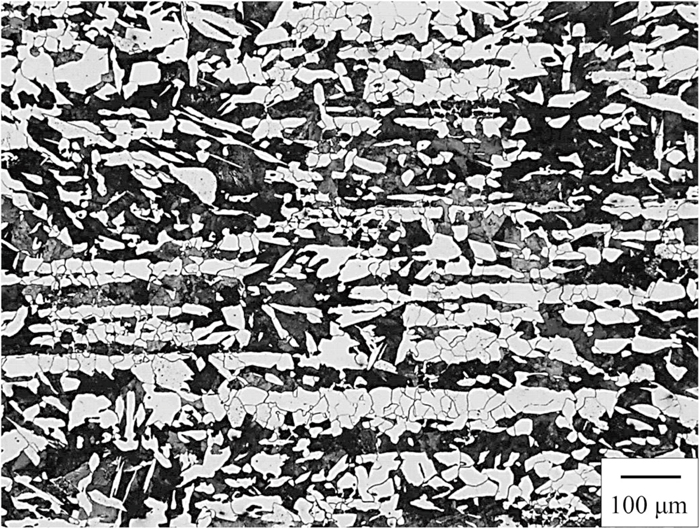
Optical micrograph of the ferrite-pearlite steel obtained by a JIS-S35C steel.
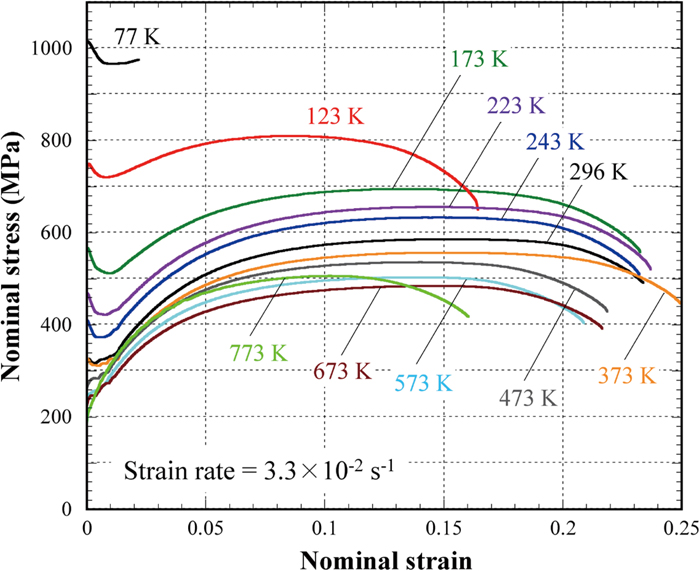
Nominal stress–nominal strain curves of the ferrite-pearlite steel at various temperatures. (Online version in color.)

Mechanical properties as a function of deformation temperature in the ferrite-pearlite steel. (Online version in color.)
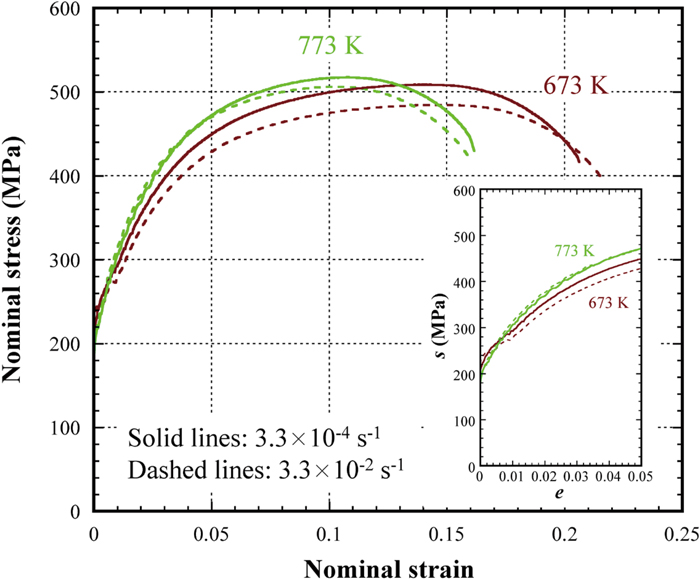
Nominal stress–nominal strain curves of the ferrite-pearlite steel with strain rates of 3.3 × 10−2 and 3.3 × 10−4 s−1 at 673 and 773 K. (Online version in color.)
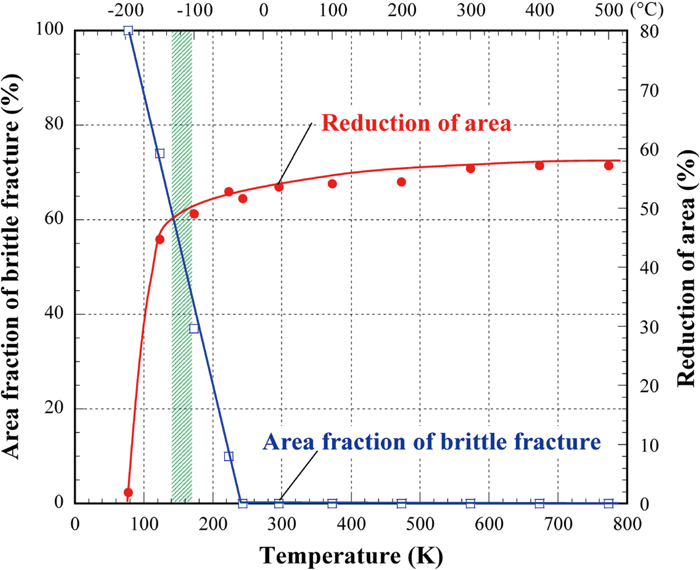
Area fraction of brittle fracture and reduction of area as a function of deformation temperature. (Online version in color.)
Figure 6 shows the fracture surfaces of the FP steel at various deformation temperatures between 77 and 773 K. The insets in the upper left corners are low-magnification images of the fractured specimen at each temperature. Full dimples can be seen at temperatures higher than 243 K and dimples of almost the same size were observed in most cases. On the other hand, a river pattern was observed in part of the fracture surfaces at temperatures below 223 K. As described earlier, the change in the fracture surface with a decrease in the temperature is associated with the reduction of area below 223 K, as seen in Fig. 5. Figure 7 shows high-magnification images of microvoid coalescence at 123 K (a) and 173 K (b), at which the area fraction of brittle fracture is greater than 40%. Those microvoid coalescences seem to be formed by a ductile fracture mechanism and consist of small regions formed by the pearlite lamellae. Such microvoids were also observed in the fracture process zone of pearlite steel.16) The test specimen exhibited a brittle fracture immediately after yielding at 77 K, and only the river pattern was observed. Based on the low-magnification image of the fracture surface, it was found to be an intergranular fracture at 77 K.

Fracture surfaces of the ferrite-pearlite steel at various temperatures.
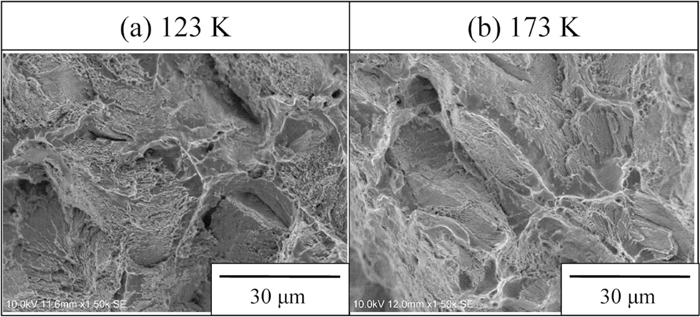
High-magnification images of fracture surfaces of the ferrite-pearlite steel at 123 K (a) and 173 K (b).
Figure 8 shows the σ–ε relationship up to the plastic deformation limit in the FP steel at various temperatures. Here, the plots represent the σ and ε values estimated using Eqs. (1) and (2), and the lines represent the calculated ones by using the following Hollomon equation:17)
| (3) |
| (4) |

True stress–true strain relationships up to the plastic deformation limit of the ferrite-pearlite steel at various temperatures between 77 and 773 K. (Online version in color.)
| Temperature (K) | K (MPa) | n |
|---|---|---|
| 77 | 1200 | 0.05 |
| 123 | 1120 | 0.1 |
| 173 | 1040 | 0.13 |
| 223 | 1000 | 0.14 |
| 296 | 950 | 0.18 |
| 673 | 900 | 0.25 |
| 773 | 850 | 0.21 |
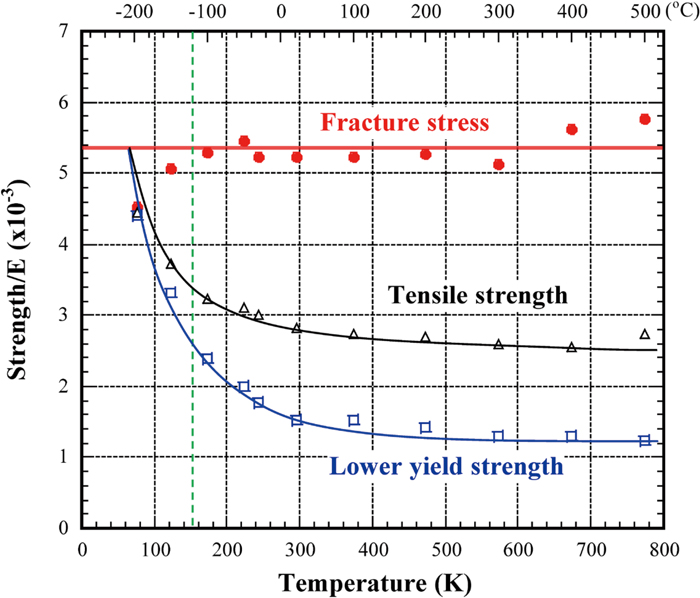
Fracture stress calculated by Eq. (4), lower yield strength and tensile strength as a function of temperature. Here, the strengths are divided by Young’s modulus at each temperature. (Online version in color.)
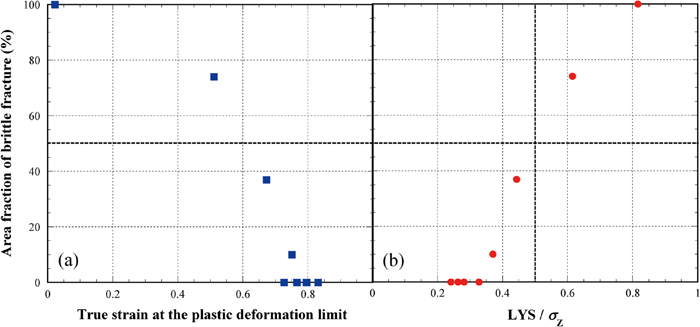
Area fraction of brittle fracture as functions of true strain at the plastic deformation limit (a) and the ratio of lower yield strength to fracture stress (LYS/σZ) (b). (Online version in color.)
Figure 11 shows SEM micrographs of the cross-sectional planes parallel to the tensile direction at ε of 0.57 (Figs. 11(a), 11(b)) and 0.64 (Figs. 11(c), 11(d)) at 296 K. In this section, the vertical axis in the SEM micrographs shows the tensile direction. Microcracks were observed in pearlite and stopped at the interface between the ferrite and pearlite or the pearlite colony boundary (Figs. 11(a) and 11(c)).6,16,23) From the high magnification images as seen in Figs. 11(b), the straight arrays of voids whose size is compatible with the thickness of cementite plate appeared, and these were aligned along the direction with around 30° from the tensile direction (vertical of the image).16,23) These voids were located at the kinked parts of cementite and a few of the kinked cementite kept connection without any failure structure. This morphology implies that the shear banding brings the formation of microcrack at the cementite. Microcracks were observed occasionally in the pearlite colonies having lamellae orientated close to the tensile direction.6,23,24,25) At the higher strained part as shown in Fig. 11(c), the macroscopic cracks were formed by linking up of the microcracks and the straight arrays of voids were less observed.
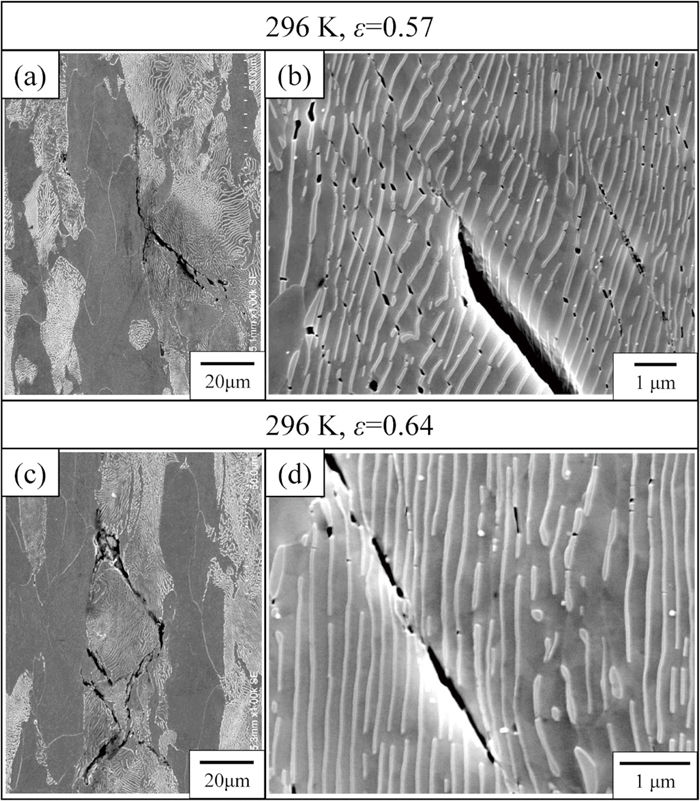
SEM micrographs of the cross-sectional planes parallel to the tensile direction with true strains (ε) of 0.57 and 0.64 at 296 K.
Figures 12 and 13 show SEM images and the orientation color maps obtained by EBSD measurements of the samples tested at 296 K at ε of 0.57 and 0.64, respectively. The results of the EBSD measurements were presented by both the color map of the crystallographic orientation parallel to the tensile direction (b), and the kernel average misorientation (KAM) map (c).26,27) Several colonies in which pearlite structure has the same longitudinal direction were observed within one block with the identical crystallographic orientation.24,28) In the SEM images, both the microcrack and their aggregations were observed. From the orientation color maps, the crack with large opening and the junction of these cracks with different elongated directions accompanies with color-gradient indicating large local misorientaions. The junction of the microcracks also shows the relative large KAM values. This seems to indicate that the local plastic deformation is caused by the growth of macroscopic cracks since the work hardening brings larger KAM values.26,27)
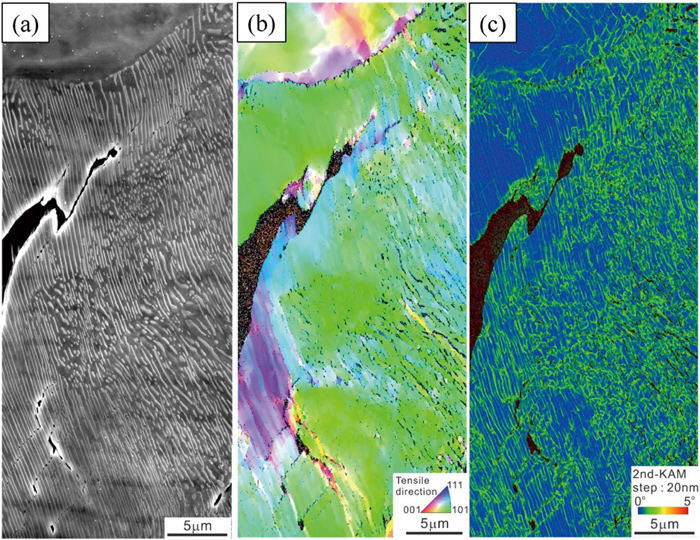
SEM image (a), orientation color map (b) and kernel average misorientation map (c) obtained by EBSD measurements of the cross-sectional planes parallel to the tensile direction at true strain of 0.57 at 296 K. (Online version in color.)
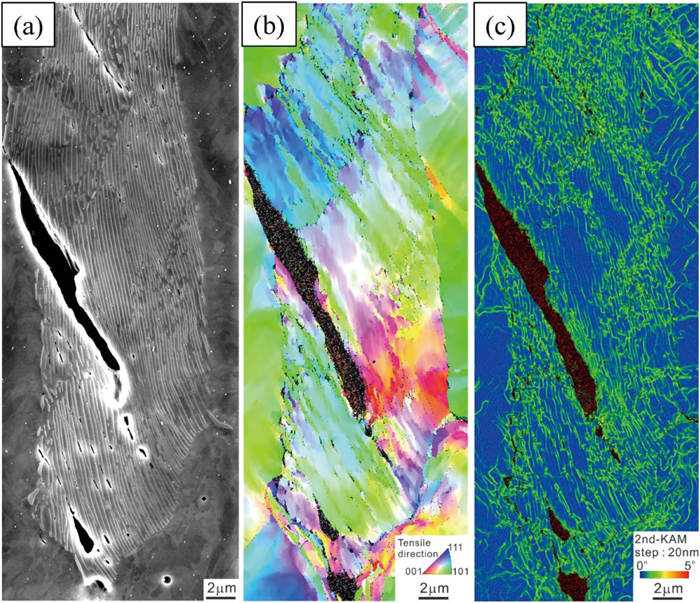
SEM image (a), orientation color map (b) and kernel average misorientation map (c) obtained by EBSD measurements of the cross-sectional planes parallel to the tensile direction at true strain of 0.64 at 296 K. (Online version in color.)
Figures 14 and 15 show SEM images, the orientation color maps and the KAM maps of the samples deformed at 123 and 77 K, respectively. The number of microcracks decreased with a decrease in temperature and the microcracks of cementite lamellae as seen in Figs. 11(b) and 11(d) were also observed. The changes of orientations for ferrite near microcracks at 123 K (Fig. 14(b)) were larger than those at 296 K (Figs. 12(b) and 13(b)) despite the applied ε was smaller at 123 K. As seen in Fig. 7, the microvoid coalescences at 123 K consist of small regions formed by the pearlite lamellae.16) The propagation of microcracks in Fig. 14 seems to have resulted in the fracture surface seen in Fig. 7(a).

SEM image (a), orientation color map (b) kernel average misorientation map (c) obtained by EBSD measurements of the cross-sectional planes parallel to the tensile direction at true strain of 0.41 at 123 K. (Online version in color.)
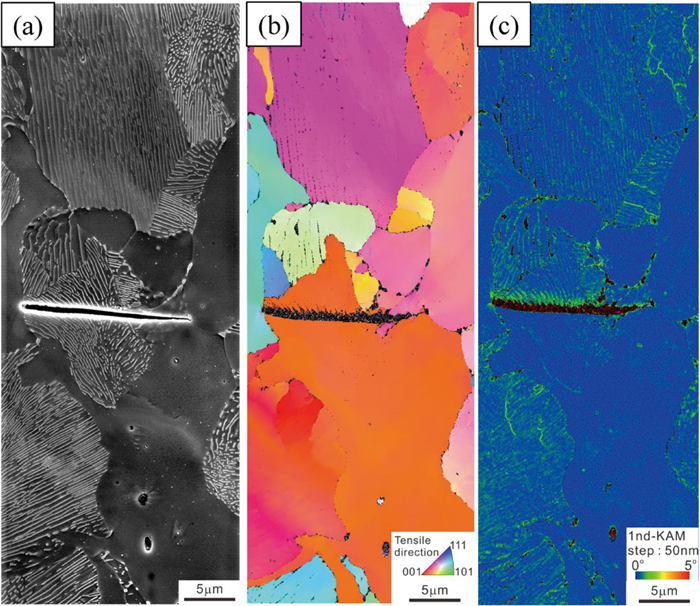
SEM image (a), orientation color map (b) and kernel average misorientation map (c) obtained by EBSD measurements of the cross-sectional planes parallel to the tensile direction at true strain of 0.03 at 77 K. (Online version in color.)
In Fig. 15, the propagating direction of crack at 77 K looked perpendicular to the tensile direction and this morphology was different with those at other temperature. The orientation color (b) around the right-side edge of the crack appears red indicating the tensile direction is nearly parallel to 001. This is consistent with the well-known fact that the cleavage fracture surface in BCC metal is usually parallel to {001}. So that the fracture mechanism of the samples deformed at 77 K can be regarded as brittle fracture.
From the SEM observations of the cross-sectional planes parallel to the tensile direction at various temperatures, the introduction and propagation of microcracks were observed in the pearlite colonies except for the brittle fracture in the present FP steels. In the ductile fracture, the microcracks were observed in the cementite plates as well as lamellar tearing in the pearlite colonies16,23) and the orientation of ferrite near microcracks were changed.
This study examined the true stress (σ)–true strain (ε) relationship up to the plastic deformation limit in ferrite–pearlite (FP) steel at various temperatures. The main conclusions are as follows:
(1) With a decrease in the deformation temperature, the lower yield strength (LYS) and tensile strength (TS) increased and both the uniform and total elongations decreased. When the temperature was increased from 673 to 773 K, the TS increased and the uniform and total elongations decreased due to the blue brittleness.
(2) The σ–ε relationship up to the plastic deformation limit of the FP steel at various temperatures was estimated. The ε at the plastic deformation limit increased with an increase in the temperature and was correlated with the reduction of area. In the comparison of the σ–ε relationship between 673 and 773 K, the σ value was larger at 773 K up to the ε of about 0.2.
(3) From the SEM observations of the cross-sectional planes parallel to the tensile direction, microcracks were observed in the cementite plates as well as tearing in the pearlite lamellae. The orientation of ferrite near macroscopic cracks obtained by aggregations of the microcracks was changed largely. This indicates the local plastic deformation is caused by the propagation of macroscopic crack.
(4) The temperature dependence of fracture stress (σZ), which was estimated as the maximum axial stress at the center of the necking section, was small, and in particular, σZ in the temperature range of ductile fracture was almost the same, independent of deformation temperature. The critical fracture stress is independent of deformation temperature and is applicable to the condition of plastic deformation limit in the present FP steel. When the ratio of LYS to σZ was 0.5, the area fraction of brittle fracture was 50%.
A part of this work, especially EBSD study, was financially supported by Grant-in-Aid for Scientific Research (ID: 20H02488, 21H00109) through the Japan Society for the Promotion of Science (JSPS).